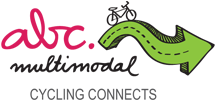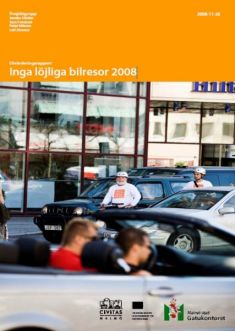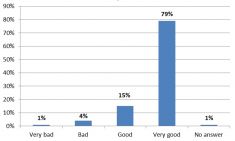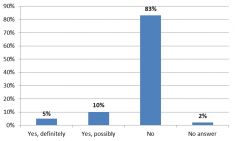Evaluation of the campaign “No Ridiculous Car Trips”
Location:
Sweden, Malmö (300,000 inhabitants)
Project description:
Starting situation and evaluated campaign
In 2007 the City of Malmö implemented a new campaign to reduce the amount of “ridiculous” car trips. For trips with distances less than 5 km cycling, walking or taking transit is encouraged. The campaign takes place annually in spring with a budget of approx. 80,000 € per year (150,000 € in the first year). The campaign stands out for their unconventional types of marketing, such as “live billboards”, in front of which real people animate the advertisement by riding a bike, or the competition, in which people can win a bike by confessing their own most ridiculous car trip.
You can find the description of the campaign here.
Objectives of the evaluation
The objectives of the evaluation were:
- Assess the success of reaching the inhabitants of Malmö
- Describe the effects of the campaign
- Keep record of the campaign’s media savvy
Evaluation concept and methods
The campaign was evaluated using SUMO, the standard evaluation system of the Road Administration of Sweden. SUMO is divided in three sections. These sections have several subsections:
- Evaluation of the campaign’s elements
(A) Media savvy of campaign
(B) Knowledge of campaign
(C) Participation in campaign
(D) Satisfaction with campaign
- Evaluation of effects
(E) Effects of campaign
(F) Effects on an individual level
(G) Satisfaction with effects (not evaluated)
- Evaluation of permanent campaign effects
(H) Permanent individual success (not evaluated)
The subsections itself were filled with specific goals such as “30% of all inhabitants shall know about the campaign” (more details in the evaluation report). The evaluation detects particularly whether these aims have been met. The methods of evaluation included a phone survey and a quantitative analysis of media coverage (print and online media as well as radio).
Representative telephone survey among inhabitants
In 300 telephone interviews the success of the campaign to reach the target group as well as its effects on people’s behaviour was assessed. The interviews were carried out by IMRI and took place in the period of 11th to 18th of June 2008. The interview partners were randomly selected. As the campaign was realized in May the interviews were conducted approx. one month later.
With 84%, response rate was very high. Participants were 15 to 70 years of age. A sample of 300 persons results in an uncertainty margin of 5.5% when the results are generalized to the total population of Malmö.
The evaluation shows, that about 40% of Malmö’s population had heard about the campaign. The evaluation’s conductors conclude that this is a high number since the project was just running for a couple of days. More than three out of four people who knew about the campaign could recall the main message of it (getting people to cycle instead of taking the car). Most people have heard about it through media coverage and advertisement in the local newspaper.
94% of all questioned people think positively about the conduction of such campaigns by the municipality.
The web played a bigger role than in the previous year. Submissions to the competition were to be sent in via the website. Even though the website registered more visitors the competition received fewer entries compared to the previous year.
21% of the interviewed inhabitants, which were aware of the campaign, changed their view on taking the car for short trips due to the campaign. Furthermore, 15% of them state, that they drive less as a result of it. All people who changed their mobility behaviour believe that they will continue cycling also on a long run.
Media coverage
The assessment of the media coverage was based on the telephone survey as well as press clippings. The effects of reports in all media types were all positive. Also, local newspapers were heavily involved in the campaign. This resulted in a good public response. The local radio was however not embedded in the campaign. As a positive side-note, also international media attention was registered.
Conclusions
Overall, the campaign has been a great success so far. The main goals as well as most side-goals could be achieved. The awareness in the population was very high as was the acceptance. A high share of people (15%) state a change in mobility behaviour due to the campaign.
It is essential to repeat the campaign annually to reach long-term effects in behavioural change. To reach people sufficiently every year, the campaign has to be adjusted and partly redesigned every time.
(Source: evaluation report of “No Ridiculous Car Trips 2008” [Utvärderingsrapport av “Inga löjliga bilresor 2008”])
Target group of the evaluation:
Politicians, administration and the public
Funding:
Confidential
Organizations responsible for the project:
Funding body:
- City of Malmö
Contractors:
- IMRI (interviews)
- Transvector (analysis)
Project term:
June – November 2008
Documentation:
The evaluation report can be found here.
Contact person:
Project management:
City of Malmö, Streets and Parks Department
Linda Medberg
E-mail: linda.medberg@malmo.se
Phone: +46 40 342138
Sara Forslund
E-mail: sara.forslund@malmo.se
Phone: +46 40 342194
Malmö stad, gatukontoret
August Palms Plats 1
205 80 Malmö
www.malmo.se
Response to the question: “Is it good that the City of Malmö conducts campaigns promoting the reduction of car usage?” Figure based on the evaluation report, p.17 © City of Malmö







